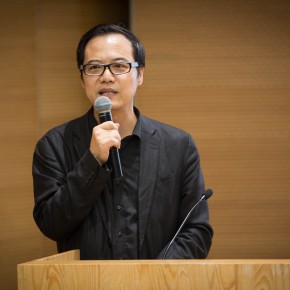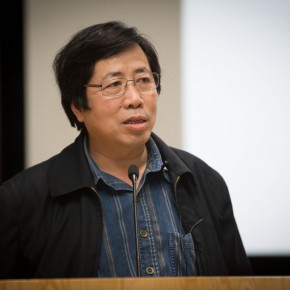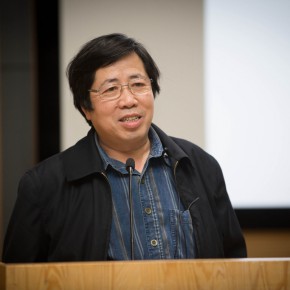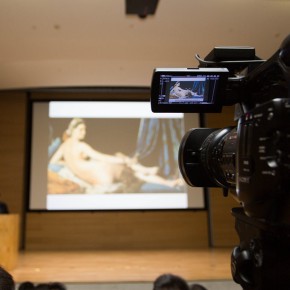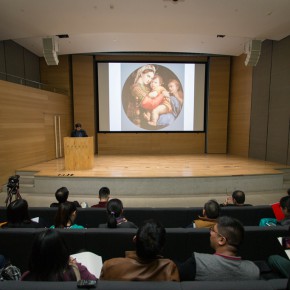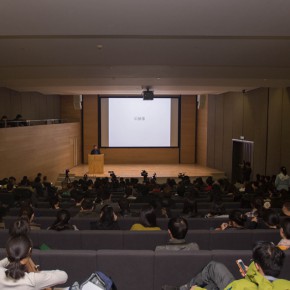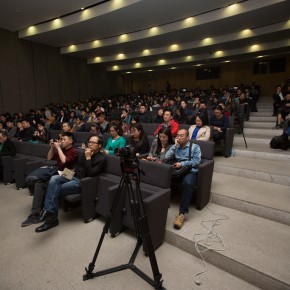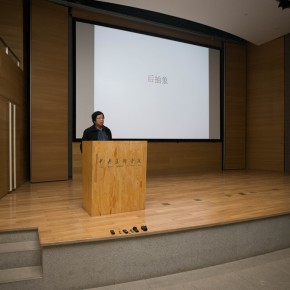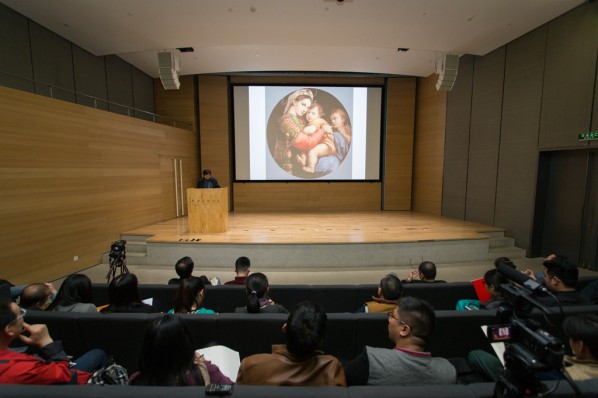
At 3:00 pm on April 17, 2015, at the Auditorium of CAFA Art Museum, the 2nd academic lecture for the “International Art Season” of the year was launched, which was entitled “Yi Ying: Post-Abstraction”, presided over by Wang Chunchen, Director of the Academic Department, CAFA Art Museum. This lecture invited Professor Yi Ying, from CAFA to speak. Yi Ying through a combination of theoretical explanation and review of work, combed through the developing context of abstract art and further clarified the concept of “post-abstraction” and the artistic development situation at the same time.
“Vasari Narration”
In order to better comb through the developing context of abstract art, Yi Ying first talked about the two types of narrative patterns of western art history: “Vasari Narration” and “Greenberg Narration”.
Grounded on “Vasari Narration”, Yi Ying showcased a lot of artworks from the Renaissance to the Neoclassicism. It was easy to see the progress of artists’ plastic skills in this artwork, especially through the neoclassical period in the 19th century, the plastic of the figures, environment and spaces reached a standard that was impossible to be exceeded. At the same time Daguerre invented photography, so that the ways of viewing and the creation, which were previously used by the artists, were replaced by machine, for example, Courbet used a large number of photos as material for the creation of painting at that time. According to the above phenomenon, Arthur C. Danto thought it indicated the end of the“Vasari Narration”.
“Greenberg Narration”
After neoclassicism, along with the birth of impressionism, it entered the “modernist narration” period as it was entitled by Greenberg, namely “Greenberg Narration”, which continued classical art, while facing the new era of industrialization and a stage of civilization, its significant symbol was “formalism” in the art. Yi Ying pointed out that, in Greenberg Narration, art changed to absolute visual complanation from absolute reality, and then moved towardsa type of “absolute abstraction”.
Sean Scully’s Abstract Art
After combing through the two art patterns, Yi Ying shifted the topic to Sean Scully’s painting exhibition which is on show at CAFA Art Museum, Yi said Scully’s painting continued with the idea of minimalism, but it was more complicated.
On the one hand, Scully’s painting was not the repetition ofa single pattern, instead the restructuring and combination of different color blocks and images, forming the language which was like “group paintings” in this expression. On the other hand, for the installation of Scully, Yi Ying said: when painting enters then the tree-dimensional and multi-dimensional levels of “things”, along with the elements such as size of work, mode of display and space changed, the audience actually entered a “theatre”, namely it was necessary for the viewers to enter the hall to fully experience the whole work, which was called “theater effect”, often appearing in the discussion of art criticism.
“Post –Abstraction”
Yi Ying said that abstract art was a way of creation that would never disappear, but perhaps it lost the pioneering and revolutionary element of early abstract art.
In addition, Yi Ying put forward two groups of concepts: “characteristics of post-abstraction” and “three basic conditions of contemporary abstraction”. Amongst the “characteristics of post-abstract” it included: on the one hand, artists generally using the resources of traditional abstract art, which were artistic elements from Kandinsky, Malevich, Mondrian, to the period of American abstract expressionism and minimalism. On the other hand, “post-abstract” art was also combined with today’s artistic culture, trying to express some views, but compared with Pop art, its expression was more subtle and circuitous.
“Three basic conditions of contemporary abstraction” included: the appeal of post-abstraction artwork as it relates to the creative sensibility of the artists themselves. Secondly, post-abstraction was the pursuit of the cultural property. Thirdly, post-abstraction was the pursuit of a clear meaning. In addition, in the stage of post-abstraction, art creation did not have an expected purpose as declared by Greenberg any more, artists often used mixed materials and new strategy for creation, attempting to change people’s previous understanding of the concept of abstraction, and constantly learned from other artistic ideological trends, while paying attention to the discovery and use of cultural resources.
Then Yi Ying introduced and reviewed the artists with the characteristics of “post-abstraction” like the western artist Philip Tuff, etc., and Chinese artists including Shang Yang, Su Xinping, Tan Ping, Wang Yigang, Li Xiangming.
Finally, it was the Q & A section, where Yi Ying answered the audience’s questions on Chinese abstract art, “abstractness”, theory of abstract art, etc..
Text by Yu Ya, Photo by Yang Yanyuan/CAFA ART INFO
Translated by Chen Peihua and edited by Sue/CAFA ART INFO


